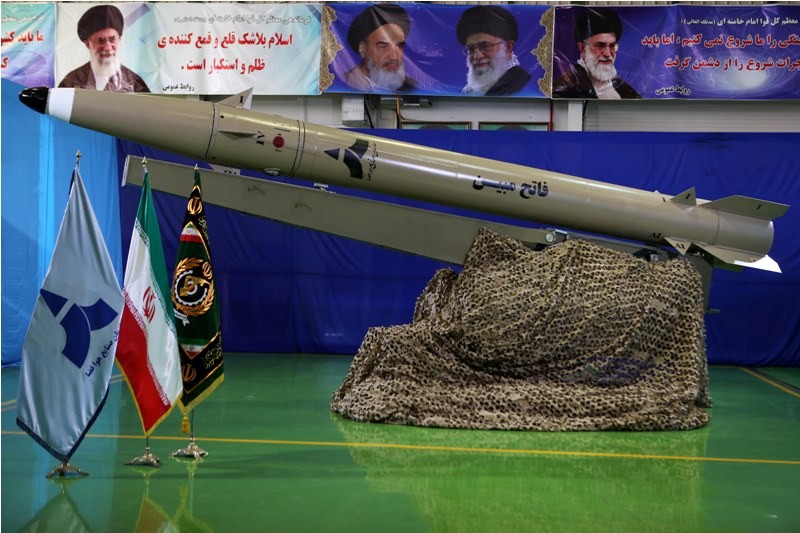On August 13th, Iran revealed its new ballistic missile called Fateh Mobin (Bright Conqueror) and capable of striking targets at land and sea.
Iranian Defense Minister Brig. Gen. Amir Hatami said the indigenously designed munition was an “agile, radar-evading and tactical missile with pinpoint accuracy,” as reported by Defense News, citing the semiofficial Tasnim News Agency.
The Defense Minister also said that the missile had been successfully test-fired. This is consistent with Free Beacon’s report that an unnamed US official said that during the week of August 6th – 10th Iran has test-fired a short-range anti-ship missile in the Strait of Hormuz during its naval military exercise.
As cited by Sputnik, featuring an estimated range between 300 and 500 km, the Al-Mobeen is said to feature improved accuracy and radar-evading capabilities. According to the defense minister, the weapon has already been tested. Created by the Defense Ministry’s Aerospace Industries Organization, the stealthy missile is said to be capable of hitting both sea and ground-based targets.
General Hatami also emphasized that Iran’s missile developments are simply a “defensive deterrent,” however also said that he would “not spare any effort” to further “increase the country’s missile capabilities,” according to FARS News, cited by Sputnik. He also further vowed that Iran would never permit foreign powers to pressure it on its missile program and that such attempts are equal to interference in the country’s domestic affairs.
Iran is thought to possess over 1,000 short and medium-ranged missiles, however it has reportedly not performed any tests in 2018, until the military exercise in the Strait of Hormuz. Sputnik cited US media, which has been told by the US military that US satellites had picked up a Fateh-110 Mod 3 missile being tested in Iran’s territorial waters during the drills.
The Pentagon refused to comment the suspected missile launch, however it said that the military drills are an obvious “message” to the US about Iran’s capabilities.
U.S. Army General Joseph Votel, head of the U.S. military’s Central Command, said earlier this week the scope and scale of the exercises were similar to ones Iran had carried out in the past. However, the timing of the exercise is different from usual and, according to him, was designed to get Washington’s attention. “It’s pretty clear to us that they were trying to use that exercise to send a message to us that as we approach this period of the sanctions here, that they had some capabilities,” Votel told reporters at the Pentagon.
“We are aware of what’s going on, and we remain ready to protect ourselves as we pursue our objectives of freedom of navigation and the freedom of commerce in international waters,” Votel further commented.
The relations between Iran and the US have rapidly deteriorated after Donald Trump’s May 8th withdrawal from the Iran Nuclear Deal. The withdrawal also included the reimposing of sanctions on Tehran, some of which went into effect on August 6th. The second batch of sanctions is to be imposed in November, and they target Iran’s oil exports in particular.
In July, to answer the threat of sanctions on Iran’s oil exports, Iran’s Supreme Leader Ayatollah Ali Khamenei backed President Hassan Rouhani’s suggestion that Iran may block Gulf oil exports if its own exports are stopped. Iran has threatened to close the Strait of Hormuz several times in the past, however it has never actually realized such a threat.
The military exercise that took place during the first week of August most likely had the purpose of showing the US that Iran is capable of closing the Strait, while also presenting its military might.
On August 3rd, Iranian foreign minister Javad Zarif blasted the US Navy, which monitored the Iranian Drills. His twitter post was the following “US Navy can’t seem to find its way around our waters. Perhaps because it hasn’t figured out its name: Persian Gulf, as it’s been called for 2,000 yrs longer than US has existed. Or maybe it doesn’t know what it’s doing in our backyard, 7,000 miles from home.” The outburst came as an answer to CENTCOM Spokesman Navy Capt. Bill Urban twitter post confirming that US Central Command is aware of the increase in Iranian naval operations in “the Arabian Gulf.”
The Strait of Hormuz, part of which constitutes Iranian territorial waters, is the choke point passage way for about 20 percent of the world’s crude oil, and carries oil from Iran, Iraq, Kuwait, Saudi Arabia, Qatar, and the United Arab Emirates. Any blockage of the route would have devastating consequences for the global economy.
The Fateh Mobin is not Iran’s only new missile this year. In April 2018, Iran presented an unidentified air-launched cruise missile during Iran’s Army Day Parade. As cited by Defense News, the missile features trapezoidal grid fins ― most commonly associated with U.S. missiles ― and a seeker in the tip.






